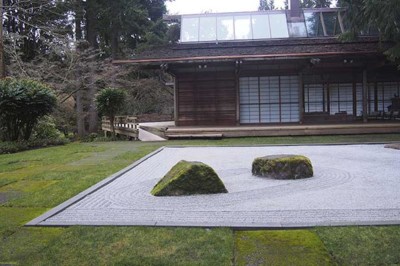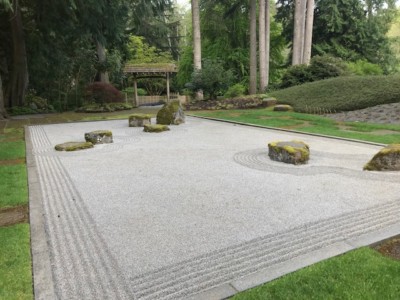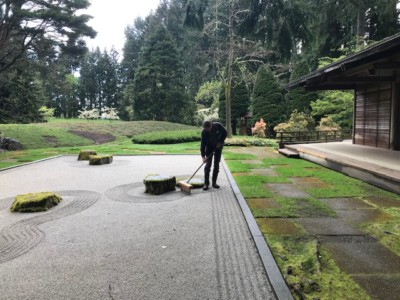The Sand and Stone Garden
The Japanese Garden at the Bloedel Reserve is considered one of the best in North America according to an annual list from the Sukiya Living Journal. One of many distinctive features of Bloedel’s Japanese Garden is its Sand and Stone Garden, which is located in front of the Japanese Guest House.
Bob Braid, Bloedel’s Japanese Garden caretaker, shares its history and some of his methods for maintaining the Sand and Stone Garden in pristine condition,
First Water, Then Sculpture, Then Stone
The site of the stone garden was originally a swimming pool used by family and guests. In the 1970s, after famed poet Theodore Roethke accidentally drowned in the pool, the Bloedels had well-known landscape architect Richard Haag replace it with a sculpture entitled “The Garden of Planes,” a beautifully graveled and shaped mound of angles and flat surfaces.
In 1987, Dr. Koichi Kawana, a landscape architect from UCLA, designed and installed the Sand and Stone Garden to replace the “Garden of Planes” sculpture. The director and the Bloedel Board felt it would be more in keeping with the design of the rest of the Japanese Garden.
Meant to Be Seen, Not Stepped On

In the majority of Japanese gardens, the stone garden component is usually meant to be viewed from a building or hillside at a distance. It is built deliberately so that the public has no access to it. The Sand and Stone Garden at Bloedel Reserve is unique in that the public can actually walk right to the edge of it, which presents a bit of a challenge. In fact, I spend a lot of time erasing the footprints of people who unknowingly walk right out into the middle of the Sand and Stone Garden, an action that we politely discourage.
The Work that Keeps It Serene

Caretaker Bob Braid at work in the Stone Garden
A lot of work goes into keeping the Sand and Stone Garden looking good. I use a very special tool to fix footprints and divots: a broom. The broom is simple but effective at moving and smoothing the granite gravel. Before using the broom, I use a backpack blower once a day to remove leaves, pine needles, and other debris. Once both footprints and debris have been shown the exit, I redo the raking pattern with a special rake that has tines made of 6 large-diameter dowels. These tines etch the pattern of parallel grooves into the gravel that are typical of stone gardens. The final pattern of the grooves depends on the person doing the raking.
Like other “living” gardens, the Sand and Stone Garden needs weeding, so once a month I weed it. It’s hard to believe weeds and moss grow in the gravel, but they do. Once a year, it gets a complete makeover and is thoroughly raked of debris, carefully releveled, and we add new granite, if necessary.
SIGN UP FOR OUR ENEWSLETTER
Stay up to date on all of the events and activities taking place at Bloedel Reserve.

